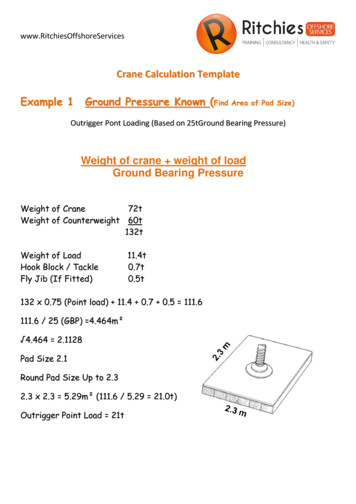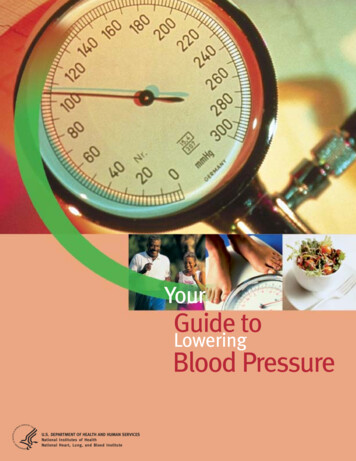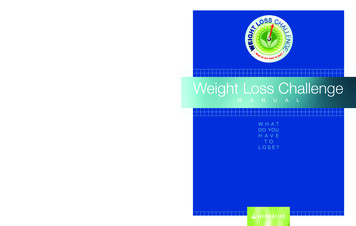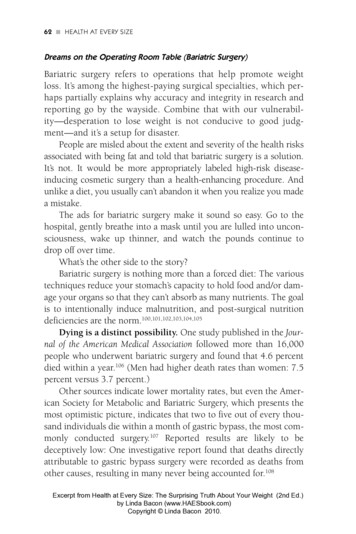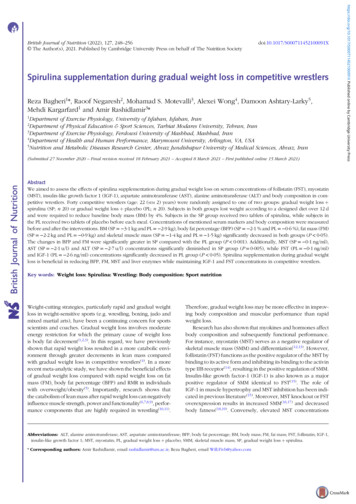
Transcription
doi:10.1017/S000711452100091XSpirulina supplementation during gradual weight loss in competitive wrestlersReza Bagheri1*, Raoof Negaresh2, Mohamad S. Motevalli3, Alexei Wong4, Damoon Ashtary-Larky5,Mehdi Kargarfard1 and Amir Rashidlamir3*1Department of Exercise Physiology, University of Isfahan, Isfahan, IranDepartment of Physical Education & Sport Sciences, Tarbiat Modares University, Tehran, Iran3Department of Exercise Physiology, Ferdowsi University of Mashhad, Mashhad, Iran4Department of Health and Human Performance, Marymount University, Arlington, VA, USA5Nutrition and Metabolic Diseases Research Center, Ahvaz Jundishapur University of Medical Sciences, Ahvaz, Iran2(Submitted 27 November 2020 – Final revision received 18 February 2021 – Accepted 8 March 2021 – First published online 15 March 2021)AbstractWe aimed to assess the effects of spirulina supplementation during gradual weight loss on serum concentrations of follistatin (FST), myostatin(MST), insulin-like growth factor 1 (IGF-1), aspartate aminotransferase (AST), alanine aminotransferase (ALT) and body composition in competitive wrestlers. Forty competitive wrestlers (age: 22 (SEM 2) years) were randomly assigned to one of two groups: gradual weight loss þspirulina (SP; n 20) or gradual weight loss þ placebo (PL; n 20). Subjects in both groups lost weight according to a designed diet over 12 dand were required to reduce baseline body mass (BM) by 4%. Subjects in the SP group received two tablets of spirulina, while subjects inthe PL received two tablets of placebo before each meal. Concentrations of mentioned serum markers and body composition were measuredbefore and after the interventions. BM (SP 3·1 kg and PL 2·9 kg), body fat percentage (BFP) (SP 2·1 % and PL 0·6 %), fat mass (FM)(SP 2·2 kg and PL 0·9 kg) and skeletal muscle mass (SP 1·4 kg and PL 1·5 kg) significantly decreased in both groups (P 0·05).The changes in BFP and FM were significantly greater in SP compared with the PL group (P 0·001). Additionally, MST (SP 0·1 ng/ml),AST (SP 2·1 u/l) and ALT (SP 2·7 u/l) concentrations significantly diminished in SP group (P 0·005), while FST (PL 0·1 ng/ml)and IGF-1 (PL 2·6 ng/ml) concentrations significantly decreased in PL group (P 0·05). Spirulina supplementation during gradual weightloss is beneficial in reducing BFP, FM, MST and liver enzymes while maintaining IGF-1 and FST concentrations in competitive wrestlers.Key words: Weight loss: Spirulina: Wrestling: Body composition: Sport nutritionWeight-cutting strategies, particularly rapid and gradual weightloss in weight-sensitive sports (e.g. wrestling, boxing, judo andmixed martial arts), have been a continuing concern for sportsscientists and coaches. Gradual weight loss involves moderateenergy restriction for which the primary cause of weight lossis body fat decrement(1,2,3). In this regard, we have previouslyshown that rapid weight loss resulted in a more catabolic environment through greater decrements in lean mass comparedwith gradual weight loss in competitive wrestlers(4). In a morerecent meta-analytic study, we have shown the beneficial effectsof gradual weight loss compared with rapid weight loss on fatmass (FM), body fat percentage (BFP) and RMR in individualswith overweight/obesity(5). Importantly, research shows thatthe catabolism of lean mass after rapid weight loss can negativelyinfluence muscle strength, power and functionality(6,7,8,9), performance components that are highly required in wrestling(10,11).Therefore, gradual weight loss may be more effective in improving body composition and muscular performance than rapidweight loss.Research has also shown that myokines and hormones affectbody composition and subsequently functional performance.For instance, myostatin (MST) serves as a negative regulator ofskeletal muscle mass (SMM) and differentiation(12,13). However,follistatin (FST) functions as the positive regulator of the MST bybinding to its active form and inhibiting its binding to the activintype IIB receptor(14), resulting in the positive regulation of SMM.Insulin-like growth factor-1 (IGF-1) is also known as a majorpositive regulator of SMM identical to FST(15). The role ofIGF-1 in muscle hypertrophy and MST inhibition has been indicated in previous literature(15). Moreover, MST knockout or FSToverexpression results in increased SMM(16,17) and decreasedbody fatness(18,19). Conversely, elevated MST concentrationsAbbreviations: ALT, alanine aminotransferase; AST, aspartate aminotransferase; BFP, body fat percentage; BM, body mass; FM, fat mass; FST, follistatin; IGF-1,insulin-like growth factor 1; MST, myostatin; PL, gradual weight loss þ placebo; SMM, skeletal muscle mass; SP, gradual weight loss þ spirulina.* Corresponding authors: Amir Rashidlamir, email rashidlamir@um.ac.ir; Reza Bagheri, email 452100091X Published online by Cambridge University PressBritish Journal of Nutrition (2022), 127, 248–256 The Author(s), 2021. Published by Cambridge University Press on behalf of The Nutrition Society
resulted in increased body fat in mice and extremely obesefemales(20,21). Weight loss has been shown to create MST orFST alterations. It has been previously reported that 2 d of fooddeprivation significantly decreased SMM and increased MSTexpression in the fast-twitch fibres of the anterior tibialis musclein mice(22). Additionally, Flanagan et al. reported an elevation inFST concentrations in obese females following a long-termweight loss intervention(23). We previously reported a significant increase in MST and a decrease in FST concentrations following rapid weight loss compared with gradual weight loss incompetitive wrestlers(4). Collectively, these reports indicate anobvious relationship between weight loss and changes in MSTand FST concentrations.Nutritional supplements are broadly used by athletic populations to improve body composition and exercise performance.Spirulina, spiral blue-green microalgae and filamentouscyanobacterium related to the Oscillatoriaceae family(24,25) havereceived recent attention due to their nutrient composition, whichincludes phytochemicals, essential and non-essential amino acids,essential fatty acids, fibres, vitamins and minerals(26). Moreover,spirulina supplementation has been shown to improve metabolicabnormalities such as non-alcoholic fatty liver disease bydecreasing liver enzymes aspartate aminotransferase (AST),alanine aminotransferase (ALT) and γ-glutamyl transferase(25).Importantly, spirulina is a cost-efficient supplement that iswidely available and may have favourable effects on weightloss(26). Studies regarding the effects of spirulina supplementation on exercise performance and body composition in athletesare lacking. Additionally, the decrements of lean mass following rapid weight loss periods are obvious(4). Because gradualweight loss results in a lesser catabolic environment, fluid lossand lean mass decrements than rapid weight loss(3,4,5), it isbecoming the go-to weight loss strategy in weight-class sports,mainly competitive wrestlers(4). Therefore, we evaluated theeffects of spirulina supplementation during gradual weight losson MST, FST, IGF-1, body composition and liver enzymes (ALTand AST) in competitive wrestlers.Experimental methodsSubjectsForty trained male wrestlers (age: 22 (SEM 2) years, training experience: 4·4 (SEM 1) years and stature: 175 (SEM 4·4) cm) wererecruited to participate in this study. Subjects were consideredtrained if they had wrestling training at least three times a weekfor at least 3 years before the study. Other than being trainedmale wrestlers, inclusion criteria composed of not taking anydietary supplements or medications for at least 6 months beforeenrolment in the study, no known medical issues or diseases, nosmoking or alcohol consumption, no history of endocrine dysfunction, BFP of 6 % or greater and being competitively overweight which was defined as having a current body mass(BM) at least 4 % heavier than the weight in which the participantnormally competes(4). Possible subjects were excluded from participating through failure to meet any of the previously statedinclusion criteria. Additional criteria for exclusion were a nonwillingness to continue nutritional protocols. A physician using249the Physical Activity Readiness Questionnaire and medical health/history questionnaire evaluated all these criteria. Subjects provided informed consent before study enrolment, and all protocolswere approved by the Institutional Review Board of the IslamicRepublic of Iran’s wrestling Federation (IAWF.95.4.20) and carriedout according to the Declaration of Helsinki.DesignThis study was a randomised, placebo-controlled and doubleblinded intervention. Prior to baseline measurements, subjectswere fully acquainted with all testing and experimental procedures. Subjects were randomly assigned to one of two groups:gradual weight loss þ spirulina (SP; n 20) or gradual weight lossþ placebo (PL; n 20). All subjects had to fill out a 10-d food diaryto determine their basal energy and macronutrient consumption.After completion of the 10-d food diary, subjects underwentan 8-h night fast and submitted a report to the laboratory forbaseline testing between 08.00 and 08.30 hours the next day.Subsequently, subjects began a 12-d progressive energeticrestriction diet to achieve the desired weight reduction.Subjects reported to the laboratory on day 13 for post-testing during the same time in the morning following identical proceduresas baseline testing. The study schematics are illustrated in Fig. 1.Gradual weight loss protocolSubjects in both groups lost weight based on a 12-d diet developed by Rashidlamir et al.(27), which gradually restricts energycontent over time. All subjects were required to reduce baselineBM by 4 %(4). The weight loss protocol is presented in onlineSupplementary Table S1. Subjects were able to consume waterad libitum and did not decrease their energetic consumptionduring breakfast(4). Subjects in both groups were involved indaily moderate physical activity lasting 20–40 min, which consisted of technical training.Spirulina supplementationUsing a double-blind protocol, subjects in the SP group receivedtwo tablets of spirulina (each tablet contained 500 mg) beforeeach meal (breakfast, lunch and dinner). Additionally, subjects inthe PL group received two tablets of placebo (500 mg of starch)before each meal that were similar in appearance to the spirulina-filled capsules. The nutritional value of spirulina per each100 g is all essential and non-essential amino acids, fat (monounsaturated, polyunsaturated), carbohydrates, vitamins (A, B1, B2,B3, B5, B6, B9, B12, choline, C, D, E, K), minerals (Ca, Fe, Mg, Mn,P, K, Na, Zn) and water. The selected dose and time of ingestionwere based on a prior study(28). The supplementation was monitored by phone calls, WhatsApp or Telegram software.Anthropometric and body composition measurementsSubjects were also advised to report to the laboratory for testingin a normally hydrated state after an overnight fast. Upon arrivalin the laboratory, subjects were instructed to empty their bladders immediately before measurements. BM was measured witha digital scale (SECA) to the nearest 0·1 kg. The subject’s staturewas measured with a stadiometer (SECA) to the nearest 0·1 cm.https://doi.org/10.1017/S000711452100091X Published online by Cambridge University PressWeight loss and spirulina supplementation
R. Bagheri et al.Randomly assignedinto SP or PLRecorded 10-dfood diaryBaseline testing (anthropometryand blood sampling)Post testing (anthropometryand blood sampling)SP(n 20)12-d gradual dietaryrestriction Spirulina (2 500mg - 3 /d)PL(n 20)12-d gradual dietaryrestriction Placebo (2 500mg - 3 /d)40 competitiveWrestlers12-h overnightfasting withoutphysical activityRecorded 12-d fooddiary in parallel to thedietary restriction period12-h overnightfasting withoutphysical activityFig. 1. Schematic of the study designBFP, FM and SMM were assessed by a multi-frequencybioelectrical impedance device (Inbody 720) as previouslyexplained(29). The test–retest reliability of the bioelectricalimpedance method was high (R 0·95–0·99).Blood sampling and laboratory measurementsFasting samples (5 ml) were taken from the cubital vein usingstandard procedures following an 8-h overnight fast(30).Subjects also did not participate in any training for 24 h beforereporting to the laboratory between 08.00 and 08.30 hours.Blood samples were clotted and stored for 20 min at room temperature before being centrifuged at 3000 revolutions per minutefor 20 min. Spun serum was removed from the centrifuge andfrozen at –70 C. Serum MST (human MST, Zellbio Gmbh) andFST (human FST, Zellbio Gmbh) concentrations were measuredin duplicate using ELISA kits according to the manufacturer’sinstructions. The intra-assay and inter-assay CV were 10 %and 12 % for all of the serum markers, respectively. ALT andAST enzymes were measured using Biolabo (France) basedon the manufacturer’s instructions.Nutrient intake and dietary analysisSubjects were asked to maintain a food diary for the duration ofthe study. Besides, subjects in both groups submitted 10-d foodrecords to establish baseline energy and macronutrient consumption and an additional 12-d food diary to record energyand the consumption of macronutrients during gradual weightloss protocol. Each item of food was individually entered intoDiet Analysis Plus version 10 (Cengage), and total energy consumption and the amount of energy derived from proteins, fatsand carbohydrates were assessed.Statistical analysisA priori sample size calculation was carried out using theG*Power analysis software(31). Our rationale for sample sizewas according to our previous study that evaluated the effectsof gradual v. rapid weight loss on FST and MST concentrationsin competitive wrestlers(4). Based on α 0·05, a power (1-β)of 0·85, the analysis revealed that a total sample size of at leastthirty subjects (n 15 per group) was needed to have sufficientpower to detect significant changes in the FST and MST concentrations. However, we recruited an extra 25 % of subjects (twentysubjects per group) to ensure that we achieved our target samplesize in case of potential dropouts. The normality of the data wasconfirmed using the Shapiro–Wilk test. The Student’s t test wasused for group comparisons at baseline. A two two ANOVA withrepeated measures (time (baseline v. post-test) group (SP v. PL))was used to determine the differences between the treatments.Pearson’s linear regression was used to examine the relationshipbetween continuous variables with r2 values of 0·02, 0·13 and0·26 as the threshold for weak, moderate and substantial effects,respectively, as recommended(32). Statistical significance was setat P 0·05. Cohen’s d effect size was calculated as post-trainingmean minus pre-training mean/pooled pre-training standarddeviation means(33). All analyses were performed using SPSS(version 24.0), and Graphpad Prism (version 8.4.3) was used to produce Fig. 2–4.ResultsSubjects and dietary complianceCompliance with the gradual weight loss strategy and spirulinasupplementation was 97·5 % of subjects in both SP and PLgroups. No adverse events were reported from spirulina and placebo supplementation. There was a significant main effect oftime for kilocalories, protein, fat and carbohydrate intake forboth groups (P 0·001). Subjects in both groups consumed significantly less kilocalories, protein, fat and carbohydrates ondays 1–4, 5–8 and 9–12 of the gradual weight loss protocol compared with baseline (P 0·05). Subjects in the SP group consumed significantly less fat than baseline and significantly lessthan days 1–4 compared with days 5–8 (P 0·05). Both groupsconsumed significantly less kilocalories, protein and carbohydrateson days 9–12 compared with days 1–4 (P 0·05). However, no significant group time was observed for any macronutrient consumption (P 0·05, online Supplementary Table S2).Body compositionA significant main effect of time was observed for BM (Fig. 2(a),P 0·001) and SMM (Fig. 2(g), P 0·001). A significant group time was detected for BFP (Fig. 2(c), P 0·001) and FMhttps://doi.org/10.1017/S000711452100091X Published online by Cambridge University Press250
P 0.405(b)(b)(a)0P 0.001604020–1–2–321–40Prior Post0P 0.001P 0.016BFP (%)1510–11.51.00.5Prior Post30200150100105000Prior Post–30P 0.001FM (kg)100–3P 0.001SMM (kg)SMM (kg)4020–1.0Prior PostPrior PostPrior PostPrior PostFig. 3. Effect of both groups on blood markers. (a) Myostatin (ng/ml),(b) Follistatin (ng/ml), (c) Follistatin:Moystatin ((FST:MST), (ng/ml)), (d)Aspartate aminotransferase ((AST), (u/l)), (e) Alanine aminotransferase((ALT), (u/l)), (f) IGF-1 (ng/ml). Error bars represent standard error of the mean.SP;PL.Endocrine markers–2.00Prior Post–1·6, –1·3, d 4·2, P 0·001) significantly decreased in both groups(P 0·05). The changes in BFP (Fig. 2(d), P 0·001) and FM (Fig.2(f), P 0·001) were significantly higher in SP compared with PLgroup, while the changes in BM (Fig. 2(b), P 0·405) and SMM(Fig. 2(h), P 0·673) were not differed between both groups.–0.5–1.5100.5P 0.6730.0P 0.00130PLP 0.0151.00.0Prior PostSPPrior Post(h)50100–2(g)20–15Prior Post1.5FST / MST (ng/ml)P 0.001Prior Post(f)P 0.002PLP 0.001(f)15FM (kg)SPALT (u/l)Prior PostPrior PostPrior Post(e)30(e)P 0.007205Prior PostPrior Post(d)P 0.040250–20P 0.0012.0Prior Post(c)P 0.001(d)20PL2.50.0Prior PostSPPrior Post(c)BFP (%)P 0.0050IGF-1 (ng/ml)Body Mass (kg)80Myostatin (ng/ml)Body Mass (kg)3AST (u/l)100P 0.001Follistatin (ng/ml)(a)251SPPLFig. 2. Effect of both groups on body composition markers. (a) Body mass (kg),(b) Δ body mass (kg), (c) body fat percentage ((BFP), (%)), (d) Δ body fat percentage ((BFP), (%)), (e) fat mass (FM), (f) Δ fat mass (FM), (g) skeletal musclemass ((SMM), (kg)) and (h) Δ skeletal muscle mass ((SMM), (kg)). Error barsSP;PL.represent standard error of the mean.(Fig. 2(e), P 0·001). BM (SP –3·1 kg, 95% CI –3·4, –2·8,d 4·8, P 0·001 and PL –2·9 kg, 95% CI –3·3, –2·4, d 3·1,P 0·001), BFP (SP –2·1 %, 95% CI –2·7, –1·6, d 1·9,P 0·001 and PL –0·6 %, 95% CI –1·1, –0·1, d 0·6, P 0·016),FM (SP –2·2 kg, 95% CI –2·6, –1·7, d 2·2, P 0·001 and PL –0·9 kg, 95% CI –1·3, –0·5, d 1, P 0·001) and SMM (SP –1·4kg, 95% CI –1·6, –1·2, d 3·2, P 0·001 and PL –1·5 kg, 95% CIA significant main effect of time was observed only for FST (Fig.3(b), P 0·030) concentrations. In addition, a significant group time was detected for MST (Fig. 3(a), P 0·021) and FST:MST(ratio) (Fig. 3(c), P 0·020) concentrations. MST (SP –0·1ng/ml, 95 % CI –0·1, –0·03, d 0·7, P 0·005) concentrations significantly diminished in SP group, while FST:MST (PL –0·06 ng/ml, 95 % CI –0·1, –0·01, d 0·6, P 0·015) concentrations significantly decreased in PL group. Furthermore, FST(PL –0·1 ng/ml, 95 % CI –0·3, –0·08, d 0·6, P 0·001) andIGF-1 (PL –2·6 ng/ml, 95 % CI –5·1, –0·1, d 0·5, P 0·040,Fig. 3(f)) concentrations significantly decreased in PL group.Liver enzymesA significant main effect of time was observed for AST (Fig. 3(d),P 0·027) and ALT (Fig. 3(e), P 0·001) concentrations. ASThttps://doi.org/10.1017/S000711452100091X Published online by Cambridge University PressWeight loss and spirulina supplementation
.00–0.01FST / MST–0.39BFP–0.200.38–0.01FST / MSTFST / .30MyostatinMyostatin1.00SMMBFPR. Bagheri et 0.190.38IGF-1–0.07–0.140.191.00–0.01FST / MST0.11–0.200.38–0.011.00(a2)1. 0SMM0. 50–0.51.001. 00. 50–0.5–1.0–1.0(b)(c)' Follistatin (ng/ml)' Myostatin 5–1.0p 0.060–42p 0.0684–4–2' Body fat %(d)(f)FST : MST (ng/ml)' IGF-1 00.50.0–0.5–1.5–2.00.0–0.2–0.44p 0.797–1.020100–10–0.5–2.0–1.5–1.0-0.5' SMM (kg)–1.0–0.50.60.40.20.0–0.2–0.4p 0.664–2.5–1.5' SMM (kg)(i)30–20p 0.687' SMM (kg)2FST : MST (ng/ml)' IGF-1 (ng/ml)' Follistatin (ng/ml)(h)–2.0–2.50.2' Body fat %1.0–2.54p 0.015*' Body fat %–1.02–0.6–0.4p 0.067–4' Myostatin (ng/ml)0.6200' Body fat %(e)30(g)https://doi.org/10.1017/S000711452100091X Published online by Cambridge University Press252p 0.989–2.5–2.0–1.5–1.0–0.5' SMM (kg)Fig. 4. Relationships between change in skeletal muscle mass (Δ SMM (kg)) and change in markers (Δ (marker)) and between change in body fat percentage (BFP) andchange in markers (Δ (marker)). a1 and a2) Correlation matrix of ΔBFP and ΔSMM with markers, r values as shown. Key indicates magnitude of r (yellow 1 green 1,white 0). (b)–(e) linear regression (Pearson’s) of Δ (marker) as a function of Δ body fat% (%), (F)–(I) linear regression (Pearson’s) of Δ (marker) as a function of Δ SMM(kg). Linear regression indicated by black line, 95 % CI indicated by green and yellow zones. Open white circles indicate PL group and closed black circles indicate SPSP; PL.group.(SP 2·1 u/l, 95 % CI 3·6, 0·6, d 0·6, P 0·007) and ALT(SP 2·7 u/l, 95 % CI 4·3, 1·1, d 0·8, P 0·002) significantly decreased in SP group. However, no significant group time difference was observed for both enzymes (P 0·05).CorrelationsTo evaluate any potential relationships between gradual weightloss-induced changes of BFP (ΔBFP) and SMM (ΔSMM) on myokines, IGF-1 and liver enzymes (Δ (marker), independent of SP
or PL group), first, two correlation matrix was generated (Fig. 4a1 and a2). FST, IGF-1 and FST:MST showed a strong negativerelationships with ΔBFP (FST:MST showed the strongest relationship), while MST showed a strong positive relationship.MST, FST and IGF-1 showed a weak negative relationship withΔSMM, while FST:MST showed a moderate positive relationship.Pearson correlation analysis revealed that there was no significant association between ΔBFP and ΔMST (r 0·30,P 0·060, Fig. 4(b)), ΔFST (r –0·30, P 0·068, Fig. 4(c)) andΔIGF-1 (r –0·30, P 0·067, Fig. 4(d)). Similarly, no associationwas observed for ΔSMM with ΔMST (r –0·04, P 0·797,Fig. 4(f)), ΔFST (r –0·07, P 0·687, Fig. 4(g)) and ΔIGF-1 (r –0·07, P 0·664, Fig. 4(h)). Finally, ΔFST:MST data showed anegative correlation with ΔBFP (r –0·38, P 0·015, Fig.4(e)), while no significant correlation with ΔSMM (r 0·12,P 0·443, Fig. 4(i)) was noted.DiscussionWe evaluated the alterations of serum concentrations of MST,FST, IGF-1, AST, ALT and body composition markers followinggradual weight loss protocol with and without spirulina supplementation in competitive wrestlers. The most conspicuousobservation to emerge from the data comparison was that SP significantly reduced MST (–4·4%), AST (–8·6%) and ALT (–11 %)concentrations, while PL significantly reduced FST (–8·7%),IGF-1 (–1·2%) and FST:MST (–7·1 %) concentrations (P 0·05).Both groups significantly decreased BFP (SP: 2·1 % v. PL: 0·6 %) and FM (SP: 18·7 % and PL: 8·4 %). Interestingly,the changes in BFP and FM were significantly greater in SPcompared with the PL group (P 0·001). Therefore, current outcomes are important since we show that spirulina supplementation potentiates BFP and FM loss after a gradual weight loss incompetitive wrestlers.We demonstrated that both groups caused a significantreduction in BM (SP 3·6% and PL 3·4%), BFP, FM andSMM (SP 3·3 % and PL 3·5 %). However, our results didnot show any significant between-group differences when wecompared absolute changes in BM (P 0·405) and SMM(P 0·0673). Interestingly, it was observed that the reductionin BFP and FM was greater after SP. It seems that adding spirulinasupplementation to the gradual weight loss protocol can targetweight loss in such a way, that it tends to be more effectivethrough BFP and FM reduction. Although the role of spirulinasupplementation on body composition, especially in athletes,is not fully understood, it has been shown that spirulina supplementation has an anti-obesity effect(34). It seems that spirulinaacts via the AMP-activated protein kinase signalling pathwayand Sirtuin 1 in adipose tissue and skeletal muscle(35). It has beenindicated that spirulina supplementation activates the AMP-activated protein kinase pathway, which regulates Sirtuin 1(35).Therefore, Sirtuin 1 deacetylates metabolic molecules, includingNF-kB, c-Myc, forkhead transcriptional factor 1 and PPAR-γ,which results in an elevation of adiponectin, an adipokinethat increases with a decrement of FM(35,36). Moreover, studiesreported an increment in gene expression of PPAR-γ coactivator1-α and uncoupling protein 2 in skeletal muscle following253spirulina supplementation, which is the result of adiponectin/adipoR1 activation and consequently, the up-regulation ofadiponectin, as well as PPAR-γ coactivator 1-α and uncouplingprotein 2 that promotes the mitochondrial biogenesis and fatoxidation(35,37,38). Additionally, the activation of AMP-activatedprotein kinase inhibits acetyl-CoA carboxylase that causeslipid oxidation increment by regulating carnitine palmitoyltransferase I(39). On the other hand, it has been shown that deactivation of the acetyl-CoA carboxylase by AMP-activated proteinkinase suppresses fatty acid synthesis(35). Indeed, Heo et al. perfectly illustrated that spirulina supplementation declines theindex of white adipose tissues, including mesenteric, perirenal/retroperitoneal and epididymal in white adipose tissue(35).Both groups significantly reduced SMM (P 0·001).However, no significant between-group differences were noted(P 0·673) when we compared changes from pre-test to posttest. Maintaining SMM in wrestlers seems essential since it isstrongly associated with strength and power outcomes(10,11),which can be considered as an important target in weight lossprotocols in wrestlers. Therefore, utilising a gradual weight lossprotocol that slightly affects SMM is considered a rational optioncompared with a rapid weight loss as we have shown previously(4). It should be noted that weight loss protocols along withkeeping high protein consumption can counteract the SMM losscaused by the energy restriction(6). The most important factorresponsible for the significant decrement of SMM is proteinintake(40). Indeed, the protein quantity of the spirulina supplementation in the SP group was not sufficient to combat SMMcatabolism. Research has shown that a daily intake of 1·6 g/kgper d is sufficient in healthy individuals during resistance training(41). Furthermore, the range of 2·3–3·1 g/kg/d has been shownas the most consistently protective against SMM catabolism during energy restriction(42). Since protein intake was significantlyreduced in the SP (18·6 %) and PL (20·6%) groups, the reductionof SMM is not a surprising outcome.When spirulina supplementation was added to our gradualweight loss protocol, a visible decrease in MST concentrationswas observed. This is an attention-grabbing outcome since thedecrement of this myokine can mediate FM reduction(43).Animal studies have revealed that MST inhibition highly likelyaffects adipose tissue loss rather than the whole BM loss inhigh-fat diet-induced in mice(43,44). It has been reported thatMST up-regulation in mice leads to a remarkable increase in adipose tissue(20,45). Conflictingly, MST down-regulation in micecauses an increment of SMM but, surprisingly, decrement ofFM, which is due to elevated fatty acid oxidation(46).Therefore, it seems a significantly higher reduction of BFP wasresponsible for MST decrement in the SP group.FST and IGF-1 analysis showed a significant reduction in thePL group. Indeed, reductions in FST concentrations that coupledwith the lack of change in MST led to a significant decrease inFST/MST concentrations in the PL group. When we consideredtheir entirety, the decrement of FST/MST in the PL group highlights the importance of spirulina supplementation, whichreduced the catabolic environment in the weight loss phase ofthe SP group. Previously, we reported that rapid weight loss(reducing baseline BM by 4 % in 48 h) compared with gradualweight loss leads to a decrease in FST:MST ratio, leading tohttps://doi.org/10.1017/S000711452100091X Published online by Cambridge University PressWeight loss and spirulina supplementation
R. Bagheri et al.SMM catabolism(4). Of note, we detected that FST:MST ratio wasnegatively associated with BFP in the SP group, indicating thatthe subjects who maintain or improve the FST:MST ratio werethe ones with the greatest drops in BFP. Although it is not feasibleto assume causality from correlation, i.e., whether an elevation inFST:MST concentrations leads to the decline in BFP or vice versa;the current outcomes are consistent with the model proposed byChen et al. (2012) in which a catabolic environment via declinesin the FST and elevations in MST concentrations, and hence adiminished FST:MST ratio may explain abdominal obesity levels(47). Therefore, our findings reinforce the importance of theFST:MST ratio on body composition.Reports indicate that rapid weight loss can be associated withsignificant changes in liver enzymes(48,49). For instance, a study ofseventeen mixed martial arts competitors found that rapidweight loss was associated with an increase in lactate dehydrogenase and AST concentrations(48). Based on our outcomes, bothALT and AST enzymes were significantly reduced in the SP group(P 0·05), which supports the previous study regarding the beneficial effect of spirulina supplementation on liver enzymes(50). Ithas been suggested that spirulina may be attributed to the presence of ß-carotene, enzyme superoxide dismutase or Se andblue pigment phycocyanin(51). Therefore, spirulina supplementation has a protective effect on th
Gradual weight loss involves moderate energy restriction for which the primary cause of weight loss is body fat decrement(1 ,2 3). In this regard, we have previously shown that rapid weight loss resulted in a more catabolic envi-ronment through greater decrements in lean mass compared with gradual weight loss in competitive wrestlers(4). In a more




